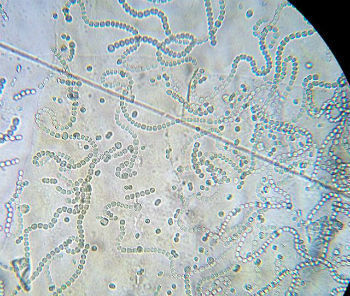Cyanobacteria are unicellular, prokaryote and photosynthetic microorganisms. They are also called blue algae or cyanophyceous algae.
Briefly, cyanobacteria are the photosynthetic bacteria.
Cyanobacteria are ancient organisms that appeared on Earth 3.5 billion years ago. Because they carry out photosynthesis, cyanobacteria were the most primitive producing beings, responsible for the initial accumulation of oxygen gas in the atmosphere.

Cyanobacteria observed under the microscope
Features
Cyanobacteria can live in isolation or in colonies. They are microscopic beings with various shapes and are usually surrounded by a gelatinous substance that prevents desiccation.
Despite having chlorophyll, as occurs in plants, in cyanobacteria there are no chloroplasts and photosynthetic pigments are dispersed in the cytoplasm.
Cyanobacteria are found in freshwater, marine environments, wet soils, frozen environments and desert regions. When there is accumulation of organic matter in these environments, cyanobacteria proliferate, giving rise to the eutrophication process.
Learn more about eutrophication.
Some species of cyanobacteria absorb nitrogen gas from the environment and transform it into ammonium ions, used for the synthesis of amino acids and nitrogenous bases.
Other species are capable of producing and releasing toxins into water. This causes the poisoning of animals and diseases to humans when consuming contaminated water.
Want to know more, read too:
Kingdom Monera
Bacteria
reproduction
Most cyanobacteria that live in isolation perform asexual reproduction by binary division.
In cases of cyanobacteria that form filamentous colonies, the filaments can fragment and give rise to other genetically identical filaments.
Importance
Cyanobacteria are of beneficial importance for nature and man. The main benefits are:
- N fasteners2 - contribute to soil and water fertility.
- Important primary producers.
- It presents value in the pharmaceutical and agricultural sectors.
However, they can also harm the environment and health. Cyanobacteria produce a strong odor and unpleasant taste in water and can unbalance ecosystems, as the water is no longer consumed by animals.
Furthermore, if water is consumed by human beings it can cause health problems.


